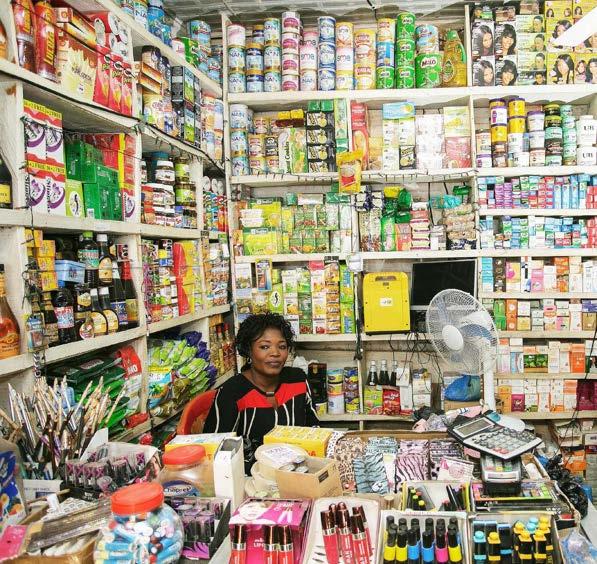
5 minute read
SUPPLY CHAIN
›A testimony from an existing customer will do more for your new business pitch than facts and figures
›Author and entrepreneur Richard Mulholland

so if you’re not happy with anything it hits the cutting room floor. These videos run from a minute to three minutes (three minutes is very long, most people will tap out before it’s complete). Small snippets sprinkled throughout your presentation or website will probably be best.
Remember, you can’t big yourself up as the hero in a story, but you can certainly bring someone else into the room to do just that. So let’s decide who to call.
The next time you have an all-hands meeting, ask your colleagues the following question:
If we had a big pitch next week and we could have any one of the customers that you have worked with in the last six months in the room selling on our behalf, who would you choose and why?
Then send the following mail to each of them: Hey [name],
Thanks so much for giving us the opportunity to work with [their company name], it meant the world to us and the team just loved working with you – we hope you feel the same way?
If you do, could I bother you to jump on a fifteen-minute Zoom call? We’ll just ask you a few questions about your experience and use your honest answers to help us to do more great work for customers like you.
We’re proud to have worked with a brand like yours and we’d love to shout about it from the rooftops.
And don’t worry, we’ll edit the call to make sure you look and sound great, and you will get to double-check everything before we put anything out in the world :)
Clients who say ‘yes’ will sell your story
Some customers won’t or can’t (company policy) help you, and that’s okay. Not a single one will mind you asking though.
The ones who say yes, will sell your story for you … and that’s a beautiful thing.
**At the time of this writing I recommend Zoom as there are settings that allow you to record HD two separate video feeds, you and customer. This makes editing much easier.
Here Be Dragons – How to Win Deals and Influence Ideas by Mastering the Eloquent Art of Storyselling was published in November 2021 by Tracey McDonald Publishers. It is available in paperback and is sold online and in bookstores.
TRACEY MCDONALD PUBLISHERS; : TIMA MIROSHNICHENKO PHOTOS: AND KAMPUS PRODUCTION FROM PEXELS)


Route-to-market in emerging markets: Framework and key steps
In the second of a two-part series, Tielman Nieuwoudt discusses the Design and Enablers phases of developing a supply chain route-to-market strategy.

ONCE YOU HAVE COMPLETED your Analysis phase (discussed in Issue 1 2022 of the magazine), you need to start the Design process. The Design phase is segmented into four major building blocks that comprise the distribution model, sales, logistics, and execution & measurement.
SALES BUILDING BLOCKS
The sales building blocks focus on sales,
order management, outlet development and money-collection activities.
Recruitment of new outlets: Design the steps to identify and activate a new outlet. Recruitment of outlets can be done by adding the responsibilities to a salesperson’s role, or creating a dedicated team of outlet activators or recruiters.
Order management: Develop all activities related to managing customer orders, both manually and electronic – such as e-commerce. Consider documentation and tracking of orders.
DESIGN
BUILDING BLOCKS
Model Territory Distribution model Financials Outlet survey
Sales Recruitment
Logistics Warehouse
Execution & Measurement Merchandising
Order management
Inventory control
Equipment management Outlet development Collection
Transportation Routing
Channel standards Compliance
DISTRIBUTION MODEL
The distribution model building blocks consider the model type, territory, financials and the need for an outlet survey. Key questions could include: l Do you build your own physical distribution network or make use of third parties? l Do you create a distribution system or rely only on passive wholesalers? l What is the role of the model? l Are distributors given exclusivity within territories and channels? l What is the size of the distribution territory? l Do you understand the trade margins and are these in line with your financial assumptions? l Do you understand the profitability of each model? l How will you support the distribution model? l Are there aspects you would like to control – such as account development and recruitment of new outlets? l How much investment will each distribution model require? l Are there opportunities to share resources and infrastructure with other non-competing companies? l Do you have a well-defined outlet survey, understanding both the existing and potential outlet base?
Outlet development: Review the outlet development plan and how to create additional demand, sales and profits within existing customers. These activities include selling new products, negotiating space for products, and developing close relationships with the customer.
Collection: Map out the receiving of money from the customer. This could be done electronically or by collecting cash in person. It is important to understand when cash is collected. In some informal markets, getting the order and collecting cash are done at separate stages. Sometimes cash is only collected later in the day — when the outlet has sufficient cash to pay for the goods.
LOGISTICS MANAGEMENT
Logistics refers to the overall process of managing and transporting inventory from manufacturing to storage, then on to the final destination. The final destination could be an outlet – ready to serve the end consumer. The logistics building blocks focus on warehousing, inventory control, transportation and routing.
Warehousing & Inventory: Review warehousing and the act of storing goods that will be sold or distributed later. Consider where products are stored, the shelving and racking system being used, inventory-control system, material-handling equipment, security, and yard management.
Transportation: Assess the process of physically transporting goods from manufacturing to the customer, and unloading products at the customer location. The actual sale becomes a reality when the delivery team delivers the products – ensuring the products are available in the outlet. Transportation also needs to take into consideration the










